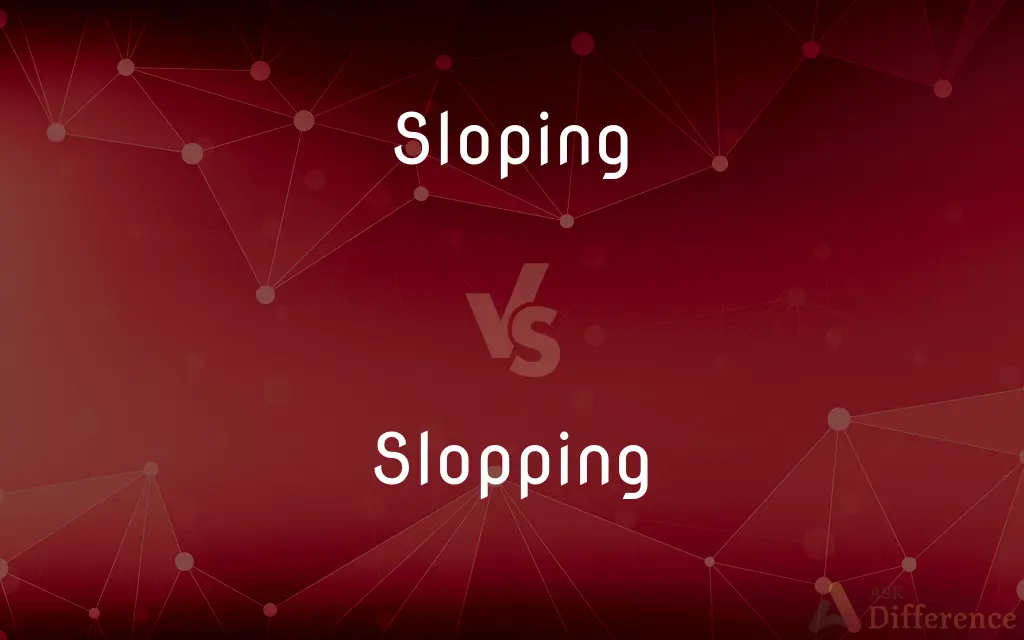Sloping vs. Slopping — What's the Difference?
Edited by Tayyaba Rehman — By Urooj Arif — Updated on March 28, 2024
Sloping refers to a gradual incline or decline in surface, while slopping involves spilling or splashing liquids messily.

Difference Between Sloping and Slopping
Table of Contents
ADVERTISEMENT
Key Differences
Sloping describes the angle or gradient of a surface, indicating its rise or fall over a certain distance. It's a term often used in geography, architecture, and various design fields to describe the orientation of land, floors, or any planar surface. Whereas slopping is primarily associated with the act of moving liquids in a careless or uncontrolled manner, often resulting in spills and messes. This term is commonly used in contexts like feeding animals or handling liquid waste.
Sloping surfaces are integral to the design of landscapes, buildings, and roads, ensuring proper drainage, stability, and aesthetic appeal. On the other hand, slopping can refer to the disposal of waste liquids in agriculture or the messy handling of substances in various settings. While sloping requires careful calculation and planning to achieve the desired outcome, slopping often implies a lack of precision and control.
In engineering and construction, sloping is critical for managing water runoff and preventing soil erosion, highlighting the importance of precision and forethought in these fields. Slopping, however, might be considered in scenarios like slop sinks in hospitals or kitchens, where the focus is on functionality rather than precision.
Sloping also plays a significant role in accessibility design, such as creating ramps for wheelchairs, ensuring a gentle incline for ease of use. Conversely, slopping is a term rarely used in a positive context, as it suggests carelessness or inefficiency, especially when dealing with potentially hazardous materials.
Despite their phonetic similarities, sloping and slopping cater to distinct contexts and usages. Sloping is about measured angles and gradients for practical and aesthetic purposes, whereas slopping deals with the often unintended movement or spilling of liquids.
ADVERTISEMENT
Comparison Chart
Definition
Refers to the gradual incline or decline of a surface.
Involves spilling or splashing liquids in a careless manner.
Context
Geography, architecture, and design.
Feeding animals, handling liquid waste.
Purpose
To ensure stability, proper drainage, or aesthetic appeal.
Often associated with waste disposal or messy handling of liquids.
Implication
Precision and planning are crucial.
Implies a lack of control or carelessness.
Example Uses
Designing landscapes and ramps.
Disposing of waste liquids in agriculture.
Compare with Definitions
Sloping
Designed with a specific gradient for water runoff.
The sloping driveway prevented water from pooling near the garage.
Slopping
The act of spilling or splashing liquids.
He was careless, slopping water all over the floor as he walked.
Sloping
Oriented at an angle to the horizontal or vertical.
The artist painted a sloping roof to add character to the house.
Slopping
Moving or pouring liquids without precision.
Slopping the soup into bowls, she hurriedly prepared for the guests.
Sloping
A gradual incline or decline in surface.
The sloping hillside was perfect for a scenic drive.
Slopping
Associated with messy or wet conditions.
After the rain, the yard was a slopping mess that needed cleaning.
Sloping
Having an inclined posture or direction.
She adjusted the painting until it was no longer sloping.
Slopping
Handling liquids in a careless manner.
The sloppy movement of the ship caused the cargo to start slopping around.
Sloping
Related to the angle between two surfaces.
Engineers calculated the sloping angle for the new ramp.
Slopping
Feeding pigs or animals with wet feed.
Farmhands were busy slopping the pigs at dawn.
Sloping
To diverge from the vertical or horizontal; incline
A roof that slopes.
Slopping
Spilled or splashed liquid.
Sloping
To move or walk
"Without another word he turned and sloped off down the driveway" (Roald Dahl).
Slopping
Soft mud or slush.
Sloping
To cause to slope
Sloped the path down the bank.
Slopping
Unappetizing watery food or soup.
Sloping
An inclined line, surface, plane, position, or direction.
Slopping
Often slops Waste food used to feed pigs or other animals; swill.
Sloping
A stretch of ground forming a natural or artificial incline
Ski slopes.
Slopping
Often slops Mash remaining after alcohol distillation.
Sloping
A deviation from the horizontal.
Slopping
Often slops Human excrement.
Sloping
The amount or degree of such deviation.
Slopping
Repulsively effusive writing or speech; drivel.
Sloping
The rate at which an ordinate of a point of a line on a coordinate plane changes with respect to a change in the abscissa.
Slopping
To be spilled or splashed
Suds slopped over the rim of the washtub.
Sloping
The tangent of the angle of inclination of a line, or the slope of the tangent line for a curve or surface.
Slopping
To spill over; overflow.
Sloping
Offensive Slang Used as a disparaging term for a person of East Asian birth or ancestry.
Slopping
To walk heavily or messily in or as if in mud; plod
"He slopped along in broken slippers, hands in pockets, whistling" (Alan Sillitoe).
Sloping
Having a slope.
A sloping roof
Slopping
To express oneself effusively; gush.
Sloping
Present participle of slope
Slopping
To spill (liquid).
Sloping
An arrangement or motion by which something slopes.
Slopping
To spill liquid on.
Sloping
Inclining or inclined from the plane of the horizon, or from a horizontal or other right line; oblique; declivous; slanting.
The sloping land recedes into the clouds.
Slopping
To serve unappetizingly or clumsily; dish out
Slopped some lasagna onto his plate.
Sloping
Having an oblique or slanted direction
Slopping
To feed slops to (animals)
Slopped the hogs.
Sloping
Having a slanting form or direction;
An area of gently sloping hills
A room with a sloping ceiling
Slopping
Present participle of slop
Slopping
Liquid that has been slopped.
Common Curiosities
Can slopping be intentional?
While slopping often suggests carelessness, it can be intentional, such as when slopping pigs, implying feeding them with wet food.
Why is sloping important in design?
Sloping is crucial in design for managing water runoff, preventing soil erosion, and ensuring accessibility and visual appeal.
What industries might use the term slopping?
Industries related to agriculture, waste management, and sometimes culinary fields might use the term slopping when referring to the handling of liquids.
Can sloping be adjusted?
Yes, sloping can be adjusted through construction or landscaping efforts to achieve desired drainage or aesthetic outcomes.
What does sloping mean?
Sloping refers to a surface that gradually inclines or declines, indicating its angle relative to a horizontal plane.
What role does sloping play in environmental management?
Sloping plays a vital role in environmental management by controlling erosion, managing water flow, and supporting habitat creation.
Are there tools specific for slopping?
Yes, tools like slop buckets and brushes are used in contexts where controlled slopping or cleaning up after slopping is necessary.
How is sloping used in construction?
In construction, sloping is essential for creating surfaces with specific gradients for drainage, stability, and aesthetic purposes.
How do gradients relate to sloping?
Gradients are a measure of the steepness and direction of a slope, directly relating to how sloping is quantified and designed.
What is slopping?
Slopping involves handling or spilling liquids in a careless or uncontrolled manner, often resulting in messes.
How does sloping affect landscaping?
Sloping affects landscaping by determining water flow, enhancing visual interest, and influencing plant placement based on drainage and sun exposure.
How do professionals measure sloping?
Professionals use tools like inclinometers, levels, and software to measure and plan sloping in various projects accurately.
Is slopping always negative?
While slopping usually has a negative connotation related to messiness or inefficiency, in some contexts, like animal feeding, it can be a neutral term.
What is a common mistake with slopping?
A common mistake with slopping is not taking precautions to prevent spills or messes, leading to hazardous or unhygienic conditions.
Can slopping affect health and safety?
Improper slopping can lead to slips, falls, and other accidents, affecting health and safety in residential and commercial spaces.
Share Your Discovery

Previous Comparison
Choad vs. Chord
Next Comparison
Universe vs. GlobeAuthor Spotlight
Written by
Urooj ArifUrooj is a skilled content writer at Ask Difference, known for her exceptional ability to simplify complex topics into engaging and informative content. With a passion for research and a flair for clear, concise writing, she consistently delivers articles that resonate with our diverse audience.
Edited by
Tayyaba RehmanTayyaba Rehman is a distinguished writer, currently serving as a primary contributor to askdifference.com. As a researcher in semantics and etymology, Tayyaba's passion for the complexity of languages and their distinctions has found a perfect home on the platform. Tayyaba delves into the intricacies of language, distinguishing between commonly confused words and phrases, thereby providing clarity for readers worldwide.















































